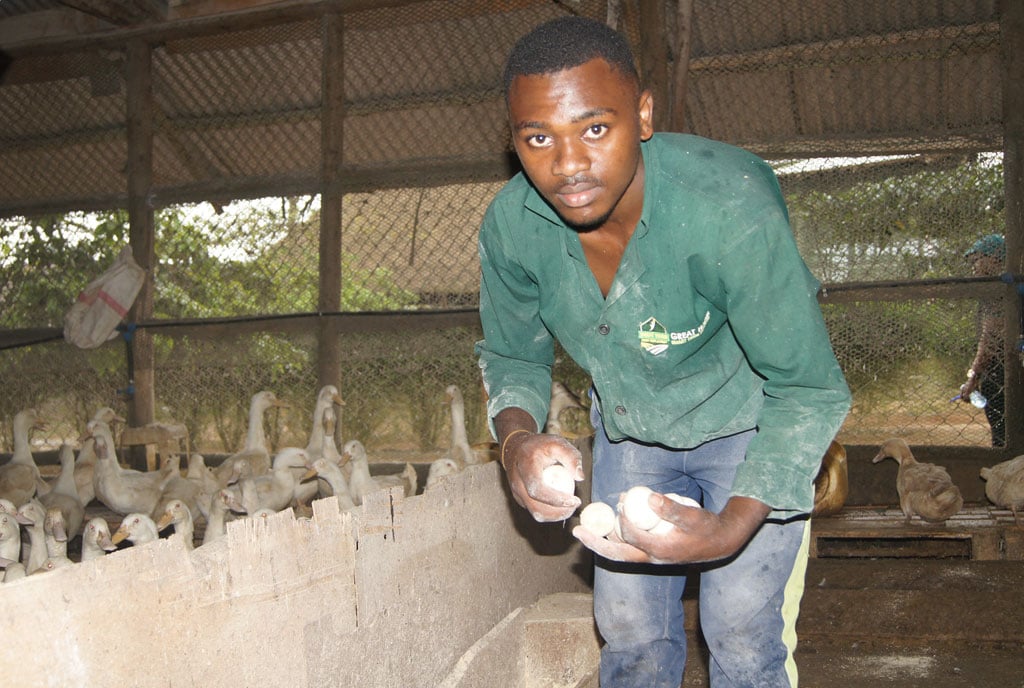Prime
How to rear ducks well

A farm employee shows eggs of a duck. PHOTO/COURTESY
What you need to know:
- Ducks kept in the free-range system are reared with minimal attention by the farmer since they are able to balance their nutrient intake by feeding on grasses, seeds, insects, earthworms, snails and small fishes, among others.
Ducks are beautiful birds, easy to keep and they bring warmth to a farm because of their economic and aesthetic benefits.
As any other poultry, you have to think wisely before rearing ducks. Keep in mind where they will be housed, their safety from predators during the day, water facilities, feeds and health management. Here are things to consider before starting.
Find out your main purpose for raising ducks. Do you want to produce eggs, meat or both? This will also guide you in determining which breeds of ducks you should be looking for.
Location
The area in which you intend to put up the unit should be considered since ducks mostly prefer foraging and availability of natural vegetation and insects is important. Also, some duck breeds are noisier and may be a nuisance to neighbours.
Management
The type of management system you choose will depend on your resources. First, you may decide to completely confine the birds, in which case they will be completely dependent on you.
Second, you can allow them to roam on the farm and confine them at night while third, you can keep them in confined runs.
Marketing
You need to carry out a market survey to determine the type of market and customer base you target.
Breed selection
Selecting the right breed of duck greatly contributes to the success of the business. Kindly consider the ease of availability of the breed you intend to keep.
The Pekin breed is by far the most popular for meat production given its high growth rate, enabling it to attain market weights of 2.5kg in seven to eight weeks.
The Muscovy breed, popular due to the high adaptation to scavenging conditions, is also a suitable breed for meat.
However, it has relatively low growth rate but it is able to attain 4.5 to 5.5kg at 12 weeks.
If your interest is in egg production, consider the Khaki Campbell breed since it is able to lay 300 to 330 eggs per year under intensive system and 175 to 225 eggs per year under semi-intensive system. Its eggs are large, thick-shelled and weigh about 70 to 75g.
Housing
Ducks can be reared under intensive, semi-intensive or free-range systems. Under intensive system, allow a floor space of 4 to 5 square feet per duck for the laying breeds and 3 square feet per bird for the meat breeds.
The house should be well-ventilated, dry and rat proof while the floor should be partly covered with litter material (wood shavings, rice husks or wheat straws) and partly with wooden slats or wire mesh.
For the semi-intensive system, the house should have easy access to outside runs as ducks prefer to be outdoor during the day.
Provide a floor space of 3 to 4 square feet per duck for the night shelter and 10 to 15 square feet per duck for the outside confined run.
Under free-range system, 250 ducks can be accommodated in quarter acre land (highly dependent on forage availability).
Water for swimming is not an essential feature, however, continuous water flow channel with dimensions of about 20 inches wide by 6-8 inches deep should be constructed where outside runs are provided or at one of the end of house.
This allows the birds to immerse their heads in the water to prevent scaly, crusty or in extreme cases blindness.
Feeding
Ducks kept in the free-range system are reared with minimal attention by the farmer since they are able to balance their nutrient intake by feeding on grasses, seeds, insects, earthworms, snails and small fishes, among others.
However, in confinement, the farmer must provide the birds with balanced feeds to enhance productivity. Ducks eat more than chicken and depending on size, an adult duck can consume between 150–200g of feeds a day.
Given the high level of feed intake and costs involved, it can be quite expensive and uneconomical to completely confine the birds, and as such the semi-intensive system would suffice.
Under the system, feeds should be offered only twice in a day, at 8am and at 4-5 pm, while they are let out to forage.
This way, the total amount of commercial feeds consumed in a day can be cut down, especially during the harvest season.




